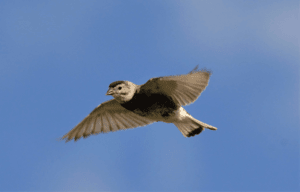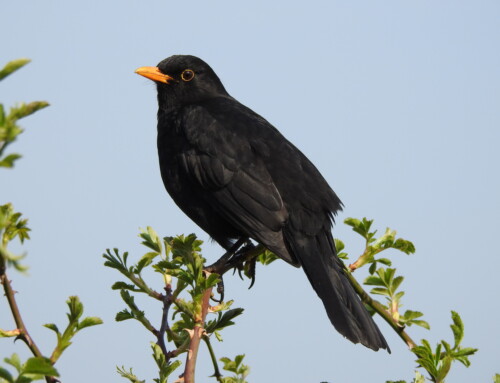 LINKED PAPER
LINKED PAPER
Detecting ecological traps in human-altered landscapes: a case study of the thick-billed longspur nesting in croplands. Swicegood, A.E., Ellison, K.S., Sather, M., Somershoe, S.G., & McNew, L.B. 2023 Ecology and Evolution. doi: 10.1002/ece3.9993 VIEW
In North America, grassland birds have declined more than any other avian guild in the past 50 years (Rosenberg et al. 2019). Conversion of native prairie to cropland is thought to be a primary driver of these declines, and intensification of agricultural practices is considered a leading cause of grassland bird declines worldwide (Ellis et al. 2010; Quinn et al. 2017).
The Thick-billed Longspur (Rhynchophanes mccownii) is a ground-nesting songbird endemic to the Great Plains of western North America. Populations have declined 4% annually over the past 50 years, and Thick-billed Longspurs are listed as a species of conservation concern (Sauer et al. 2020). This bird has a unique preference for bare ground and sparse vegetation, and it prefers to nest in short- and mixed-grass prairies historically created and maintained by heavy grazing and wildfires. Because these natural disturbances are no longer prevalent at large scales in the northern Great Plains, croplands are now the primary disturbance factor creating bare ground and sparsely vegetated habitat.
The Thick-billed Longspur, in addition to nesting on traditional native grassland, is also known to nest in cropland throughout parts of its range. When we think of birds nesting in croplands, we assume they experience many risks from seeding, tilling, herbicide application, and crop harvest. Because of their affinity for recently disturbed habitat, we hypothesized that Thick-billed Longspurs may prefer nesting in croplands over contemporary native prairies. However, if croplands are indeed poor-quality nesting habitat, they could be creating what is known as an ecological trap. An ecological trap often leads to severe population-level declines and could contribute to overall declines of the Thick-billed Longspur.
Our research
Our two-year study was conducted in northern Valley County, Montana, USA. The dominant crop in the region was spring wheat, and other common crops included pea, lentil, flax, and canola. To determine if cropland operates as an ecological trap, our first goal was to understand if Thick-billed Longspurs prefer nesting in croplands rather than native grassland. We evaluated longspur settlement patterns (or territory establishment of singing males) via acoustic monitoring, assuming earlier settlement of territories in croplands indicated a preference for cropland habitat. Our second goal was to monitor and compare longspur abundance, nest density, and nest survival in both croplands and nearby native prairie throughout the breeding season (Fig 1).

Figure 1 Thick-billed Longspur nest (a), adjacent fallow field and spring wheat crop (b), and native mixed-grass prairie in northern Montana (c) © Amber Swicegood.
Our results indicated no preference for cropland sites over native prairie sites based on settlement patterns, which were very similar in both croplands and native sites (Fig 2). Furthermore, longspur abundance and nest densities were similar in crop and native sites during both years. Abundance declined in croplands over the growing season as crop plants increased in height, but appeared unaffected in croplands during a drought year when habitat structure changed little (Fig 3). These results indicate that longspurs did indeed use croplands as nesting habitat, but not substantially more or less than native sites, and degree of use depended more on vegetation height than specific habitat type. Finally, nest survival rates were very similar in crop and native sites (0.236 ±0.028 SE), negating our ecological trap hypothesis.

Figure 2 Settlement patterns of territorial male Thick-billed Longspurs from acoustic data and dynamic occupancy models. Open circles show estimated occupancy each day (~7–30 April) during territory establishment at sites in Montana, USA, 2020–21. Whiskers indicate 95% confidence intervals.

Figure 3 Estimated plot-level longspur abundance in both crop and native sites in Montana, USA, in 2020 (top) and 2021 (bottom). A drought occurred in 2021, limiting plant growth in crop fields that year. Whiskers depict 95% confidence intervals. Survey rounds were evenly spaced between 10 May and 15 July each year.
We did not observe any acute effects of herbicide application on eggs, nestlings, or adults, although we did not evaluate toxicity directly. Interestingly, peak nest initiation occurred 6–10 days earlier in crop sites than native sites. Therefore, timing of farming operations was a critical factor in terms of nest survival in croplands, as only nests that coincided with tilling or seeding operations were directly destroyed by farm equipment. Harvest in this region occurred too late to affect nesting longspurs, as final clutches were complete by July or early August and harvest occurred in late August or September.
Conclusions
Croplands are vital for sustaining exponentially growing human populations. While preserving native grassland habitat is undoubtedly necessary for numerous grassland obligate species, the Thick-billed Longspur is unique and may benefit from these drastically altered landscapes. While Thick-billed Longspurs appear to nest successfully in a variety of crop types in northern Montana, timing of farming operations is key. Most nest destruction by farm equipment occurred in May immediately after longspurs had begun nesting. This often coincided with seeding operations, which if shifted to early or mid-April, would impact fewer longspur nests. Although longspurs will renest after failure, we stress the importance of understanding how timing of farming operations varies regionally and the impacts that these differences may have on nesting birds.
Additionally, further research investigating other aspects of longspur demography such as juvenile survival, nestling growth rates, body condition, and site fidelity to crop fields could improve our understanding of the relationship between longspurs and croplands. Although we did not observe any negative impacts of herbicide application, a toxicity study investigating sub-lethal effects would provide added insight to the risks of nesting in treated fields.
Although we do not yet have all the pieces, our short-term study provided evidence that Thick-billed Longspurs may be nesting successfully in croplands, filling a unique niche. Therefore, these small songbirds may be more adaptable than previously thought, which may allow for novel conservation opportunities in a world increasingly dominated by humans. While native grassland conservation is critical for maintaining biodiversity, some species may be rather adaptable and we should seek new conservation approaches to managing wildlife in the Anthropocene.
References
Ellis, E. C., Goldewijk, K., Siebert, S., Lightman, D., & Ramankutty, N. 2010. Anthropogenic transformation of the biomes, 1700-2000. Global Ecology and Biogeography 19:589-606. VIEW
Quinn, J. E., Awada, T., Trindade, F., Fulginiti, L., & Perrin, R. 2017. Combining habitat loss and agricultural intensification improves our understanding of drivers of change in avian abundance in a North American cropland anthrome. Ecology and Evolution 7:803-814. VIEW
Rosenberg, K. V., Dokter, A. M., Blancher, P. J., Sauer, J. R., Smith, A. C., Smith, P. A., Stanton, J. C., Panjabi, A., Helft, L., & Parr, M. 2019. Decline of the North American avifauna. Science 366:120-124. VIEW
Sauer, J. R., Link, W. A., & Hines, J. E. 2020. The North American Breeding Bird Survey, results and analysis 1966–2019. U.S. Geological Survey Data Release. VIEW
Image credit
Top right: Thick-billed longspur (Rhynchophanes mccownii) © Amber Swicegood.
If you want to write about your research in #theBOUblog, then please see here.




